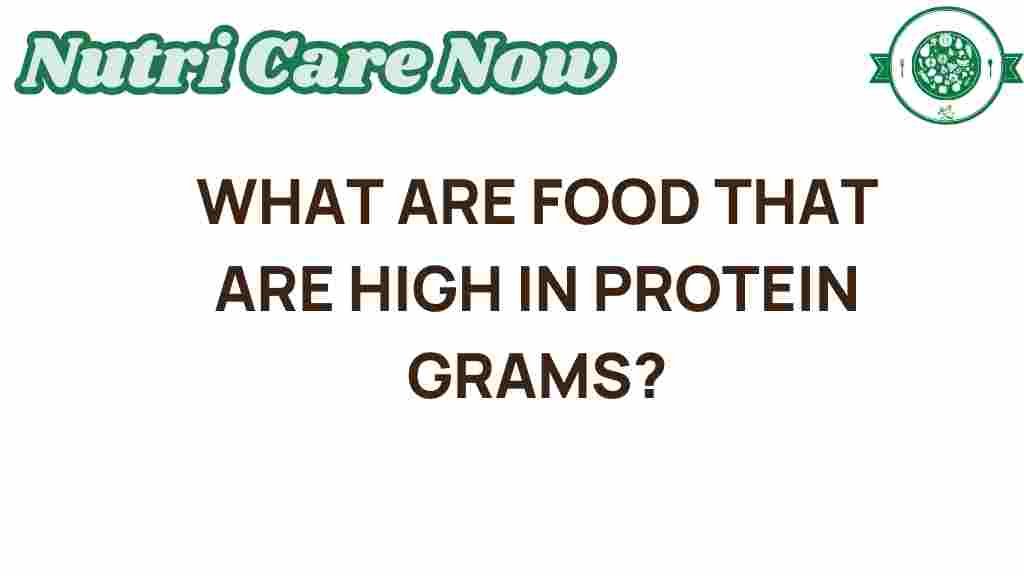Unlocking the Secrets: What Foods Are High in Protein Grams?
When it comes to maintaining a balanced diet, understanding the importance of protein foods is essential for everyone, especially for those engaged in fitness and muscle building. With the rise of health consciousness among individuals, knowledge about high protein foods has become crucial for effective weight management and overall nutrition. This article will delve into the different protein sources, their benefits, and how they play a vital role in a fitness diet. By the end, you’ll be better equipped to choose the best dietary protein options for your needs.
The Importance of Dietary Protein
Dietary protein is one of the three macronutrients essential for human health, alongside carbohydrates and fats. It plays several critical roles in the body, including:
- Building and repairing tissues, especially muscle tissues.
- Producing enzymes and hormones that regulate various bodily functions.
- Supporting immune function.
- Providing energy when carbohydrates and fats are scarce.
For those looking to enhance muscle growth, recovery, and overall health, incorporating high-quality protein foods into your diet is vital.
Identifying High Protein Foods
When searching for high protein foods, it is essential to consider both animal and plant-based sources. Below is a comprehensive list of foods that are rich in protein.
Animal-Based Protein Sources
- Chicken Breast: A favorite among fitness enthusiasts, chicken breast is lean and packed with approximately 31 grams of protein per 100 grams.
- Turkey: Similar to chicken, turkey is another lean meat, offering about 29 grams of protein per 100 grams.
- Eggs: One large egg contains about 6 grams of protein, making them a versatile and nutritious option.
- Fish: Varieties like salmon and tuna are not only high in protein (around 25 grams per 100 grams) but also rich in omega-3 fatty acids.
- Dairy Products: Greek yogurt (10 grams per 100 grams) and cottage cheese (11 grams per 100 grams) are excellent options for protein.
- Lean Beef: A great source of protein, lean beef provides about 26 grams of protein per 100 grams, along with essential nutrients like iron.
Plant-Based Protein Sources
- Legumes: Lentils and chickpeas are fantastic plant-based protein sources, offering around 9 grams of protein per 100 grams.
- Quinoa: This ancient grain contains all nine essential amino acids and provides about 14 grams of protein per 100 grams.
- Tofu: A versatile soy product, tofu has about 8 grams of protein per 100 grams and can be used in various dishes.
- Chia Seeds: These tiny seeds pack a punch with approximately 17 grams of protein per 100 grams, along with healthy fats and fiber.
- Nuts and Seeds: Almonds (21 grams of protein per 100 grams) and pumpkin seeds (19 grams of protein per 100 grams) are great snacks.
How to Incorporate High Protein Foods into Your Diet
To effectively enhance your protein intake, consider the following steps:
1. Plan Your Meals
Start by planning your meals around protein sources. Include a protein source in every meal and snack. For example:
- Breakfast: Scrambled eggs with spinach.
- Lunch: Grilled chicken salad with quinoa.
- Dinner: Baked salmon with roasted vegetables.
- Snacks: Greek yogurt or a handful of nuts.
2. Experiment with Recipes
Explore different recipes that feature high-protein ingredients. Try:
- Protein smoothies with whey or plant-based protein powder.
- Chickpea curry or lentil soup for a hearty meal.
- Quinoa salad with mixed vegetables and feta cheese.
3. Monitor Portion Sizes
While consuming high protein foods, be mindful of portion sizes, especially with calorie-dense options like nuts and seeds. Balance your protein intake with other macronutrients for a well-rounded diet.
Troubleshooting Common Issues
While incorporating more protein into your diet, you may encounter some challenges. Here are some tips to troubleshoot common issues:
1. Digestive Discomfort
Some individuals may experience bloating or digestive issues when increasing protein intake. To alleviate this:
- Gradually increase protein consumption instead of making sudden changes.
- Stay hydrated to help with digestion.
- Consider digestive enzymes if necessary.
2. Limited Options
If you find it challenging to get enough protein due to dietary restrictions (e.g., vegetarian or vegan), explore alternative sources:
- Use plant-based protein powders.
- Incorporate a variety of legumes, grains, and nuts.
- Try meat alternatives available in stores.
3. Balancing Macronutrients
While focusing on protein foods, ensure you maintain a balance with carbohydrates and fats. A fitness diet should provide all three macronutrients to support energy levels and overall health.
Benefits of High Protein Diets
Incorporating high-protein foods into your diet can lead to several benefits:
- Muscle Building: Protein is crucial for muscle repair and growth, making it essential for those engaged in strength training.
- Weight Management: High-protein diets can enhance feelings of fullness, reducing overall calorie intake.
- Improved Metabolism: Protein has a higher thermic effect compared to fats and carbohydrates, meaning you burn more calories digesting it.
- Better Recovery: Protein aids in muscle recovery post-exercise, reducing soreness and improving performance.
Conclusion
Understanding the variety of protein sources available can help you make informed choices for your health. By focusing on high protein foods and incorporating them into your meals, you can support muscle building, weight management, and overall healthy eating. Remember, a balanced diet that includes sufficient dietary protein is essential for anyone looking to improve their fitness and health. For more detailed insights on nutrition, check out this nutrition guide. To explore high-protein recipes, visit this website for inspiration and ideas.
This article is in the category Diet and created by NutriCareNow Team

2 thoughts on “Unlocking the Secrets: What Foods Are High in Protein Grams?”